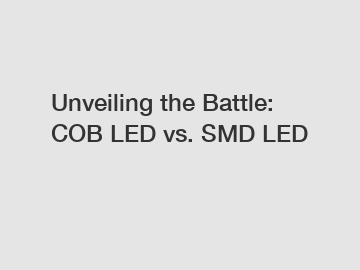Unveiling the Battle: COB LED vs. SMD LED
Welcome to our comprehensive guide on the showdown between COB LED (Chip-on-Board Light Emitting Diode) and SMD LED (Surface Mounted Device Light Emitting Diode). Lighting technology has come a long way in recent years, and these two options have emerged as popular contenders for various lighting applications. In this blog, we will explore the differences, benefits, and limitations of COB and SMD LED lights, empowering you to make an informed decision when it comes to illuminating your world.
COB LED: The Mighty Chip-on-Board (350 words):
The COB LED technology has revolutionized the lighting industry by packing multiple LED chips onto a single monolithic substrate. With this arrangement, COB LEDs have the potential to emit higher lumen output, providing more powerful illumination. The tightly packed chips produce a continuous and uniform lighting effect, free from visible individual light sources. This feature allows COB LEDs to deliver excellent color mixing, rendering accurate and vibrant colors.

Another remarkable advantage of COB technology lies in its heat dissipation capabilities. The larger surface area of the COB module ensures efficient heat dissipation, leading to overall cooler operation and an extended lifespan for the LEDs. This superior thermal management also enables COB LEDs to maintain their brightness and color consistency over time.
SMD LED: Versatility in Small Packages (350 words):
On the other side of the competition, we have SMD LEDs, which have gained popularity for their versatility and compact size. Surface Mounted Device LEDs consist of individual diodes mounted directly onto a printed circuit board. This configuration allows for flexibility in design, making SMD LEDs suitable for a wide range of applications.
The small size of SMD LEDs enables them to be used in intricate lighting fixtures, light strips, and even small electronic devices. They boast excellent energy efficiency and consume less power, making them an ideal choice for those looking to reduce energy bills while still enjoying high-quality lighting. Additionally, SMD LEDs offer a broad variety of color options, making them perfect for creating mood lighting or vibrant displays.
COB vs. SMD LED: The Showdown (250 words):
Now, let's compare the two contenders head-to-head. While COB LEDs offer unparalleled brightness and uniformity, SMD LEDs win in terms of versatility due to their small form factor. COB LEDs are primarily suited for high-intensity applications, such as outdoor lighting, stadiums, and large indoor spaces, where their high lumen output and excellent color rendering shine brightest.
On the other hand, SMD LEDs find their niche in a range of applications, including signage, automotive lighting, and household lighting fixtures. Their compact size and adaptability allow for seamless integration into various devices and architectural designs.
Both technologies have their place in the lighting industry, and the choice ultimately depends on the specific requirements of your intended application. Consider factors such as desired brightness, color accuracy, heat dissipation requirements, and installation constraints.
Conclusion (50 words):
In the end, whether you opt for COB or SMD LED technology, both offer impressive benefits and can transform your lighting solutions. The choice between these technologies should be made based on your specific lighting needs, ensuring you strike the perfect balance between brightness, versatility, and energy efficiency.
For more information, please visit Smd 5050 Led, smd cob led chip, cob led chip test.

Comments